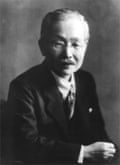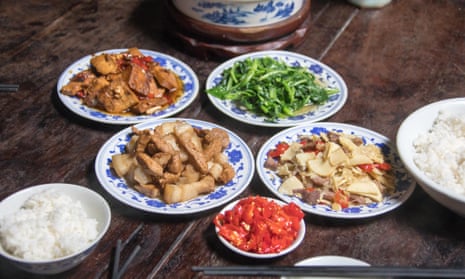I am in a restaurant in Glasgow where chopsticks stand ready in an eye-catching blue and yellow tin labelled Ve-Tsin Gourmet Powder. Produced by the Shanghai Guanshengyuan Tianchu Seasoning Company, the powder in question is monosodium glutamate (MSG). Apparently: “A sprinkling of Ve-Tsin will bring out the full natural flavour of your favourite dishes and render them surprisingly delicious.”
We are assured that it is “perfectly wholesome and nutritious”. But this being an “Asian-style” restaurant, there is no one Asian in the kitchen, or front of house, and MSG being one of the most controversial food additives, the tin has been emptied of its contents. It is only here for decorative purposes, so I won’t be able to sprinkle the white crystals in my soup if it needs pepping up.
In the west, this manufactured additive has been blamed for a number of adverse reactions – headaches, sweating, flushing, numbness of the face and neck, palpitations, nausea, chest pain and sleeplessness – known collectively as “Chinese restaurant syndrome”. Restaurants that use MSG don’t brag about it.
But is it time to revisit that stigma? MSG – or E621, to give the additive its official European E-number – is being rehabilitated by prominent “modernist” or “molecular” chefs, who borrow ingredients and techniques from the food engineering and chemical industries. In the UK, Heston Blumenthal, whose Fat Duck restaurant has three Michelin stars, is militantly pro-MSG. “The biggest old wives’ tale is that MSG is bad for you,” he says. “That is complete and utter nonsense. There is not one [scientific] paper to prove that.”

If you catch a whiff of misogyny in the term “old wives”, such chefs are more focused on another sort of bias: anti-science. In the US, chef-restaurateur David Chang, founder of the Momofuku food group, is another voluble ambassador for the “joy of cooking with science”. “Today,” he has written, “everything is supposed to be ‘natural’, simple, old-fashioned. We’ve been brainwashed to believe that science is scary. Just think about MSG, which has been banned in certain [US] cities and provokes an irrational fear in many consumers. But it’s just a sodium ion attached to glutamate, which is something your body produces naturally and needs to function. True, MSG doesn’t exist in nature; it’s a scientific invention. But multiple studies have failed to show that it makes anyone sick. It only makes food taste delicious.”
Is Chang right? E621/MSG is the manmade version of an amino acid – glutamic acid – that is found naturally in foods such as seaweed, aged parmesan, anchovies, miso, cured meats and ripe tomatoes, and is now held to be responsible for their deeply savoury tastiness. This quality is sometimes referred to as umami, the ‘“fifth taste” after salty, sweet, sour and bitter, a term coined by Japanese chemist Kikunae Ikeda. In 1908, he patented a process for extracting glutamate from seaweed and stabilising it with salt to create monosodium glutamate, a product thereafter known as Aji-No-Moto – “essence of taste”.
According to Chinese food expert Deh-ta Hsiung, the Chinese started making it from wheat in 1923, calling it Ve-Tsin, which means more or less the same thing. Nowadays, most MSG is synthesised from bacteria.

Food technologists, who know MSG as a “salivation enhancer” and “flavour potentiator”, are fully aware of its prodigious ability to modulate our perception of otherwise humdrum ingredients. Modernist chefs argue that MSG is just a handy form of the glutamate in tasty, natural foods, and no more sinister. Although Chang doesn’t use MSG in his kitchens, he has defended its use, telling a high-level meeting of top chefs that Chinese restaurant syndrome is nothing more than a “cultural construct”. That is a polite way of saying that avoidance of MSG is an expression of western ignorance, or worse, racism, drawing on stereotypes of Asian countries as dangerous or dirty.
So is the “syndrome” all in the prejudiced occidental mind? It is certainly real to several British people I talked to. One adventurous eater and traveller who believes she has experienced it describes it as “a strange warm feeling in the chest, similar to having too much caffeine, waking up with a pounding heart, and weird dreams”. It is also a reality for Ken Hom, the renowned chef and authority on Chinese cooking. He never uses MSG. “I have been allergic to it from childhood and my mum never used it in her cooking.” He draws a distinction between naturally occurring glutamate in food and the synthetic powder. “As with any good food that is properly cooked and well seasoned,” he says, “Chinese food doesn’t need MSG. We can never be sure of the long-term health implications of any artificial, manmade chemicals in our food. For me, it is a dangerous road that we don’t need to go down.”
The Aji-No-Moto company, meanwhile, insists that its MSG powder has been safely used as a food ingredient for more than a century. “It is one of the most thoroughly tested of all food ingredients, with hundreds of scientific studies confirming its safe and effective use. MSG’s safety has been repeatedly affirmed by regulators and scientific agencies around the world,” it says. But there is more to the MSG health story than that.
Although MSG is approved for use as a food additive in the European Union, processors are limited to no more than 10g per kilo of food. Higher levels are allowed in salt substitutes, seasonings and condiments, where companies are free to add what they like while observing “good manufacturing practice”, whatever that might be. As far as consumers are concerned, last year the European Food Safety Authority (EFSA) reassessed the safety of glutamate additives and came up with an “acceptable daily intake” of 30mg per kilogram of body weight for MSG and related glutamates, “below the doses that have been associated with certain effects in humans, such as headache, raised blood pressure and increased insulin levels”. (That is the equivalent of about 2g for someone weighing 70kg/11 stone.)

MSG also typically contains undesirable impurities as a result of the manufacturing process – arsenic and lead. EFSA has recommended that the current limits for these be revised, too, “to ensure that they will not be a significant source of exposure to those toxic elements”.
Manufacturers use MSG and other glutamate additives to mimic natural savoury flavours in ultra-processed products such as soup mixes, readymade sauces, savoury snacks, seasoned nuts, stock cubes and instant noodles. Ironically, they are currently reformulating products to use more glutamates than before because this allows them to cut down on salt and keep the anti-sodium brigade happy. So, in the name of supposedly healthier processed food, down goes the level of salt (a processed but nevertheless natural ingredient) and up goes the level of MSG (a synthetic additive).
But at least any company that includes MSG in a product must respect the maximum legal limit. An expert Chinese Singaporean cook was also at pains to explain to me that in Chinese home cooking MSG powder is used only very sparingly – literally a pinch in the entire dish. “Overuse of MSG masks the flavour. Importantly, it is used to mask substandard produce.” But when it comes to restaurants, who regulates the amount that is being used? If the chef puts a teaspoon, rather than a pinch, into the otherwise underpowered ramen broth, are we any the wiser? Maybe people who feel rough after a Chinese, Malaysian, Japanese or Vietnamese meal have simply been fed too much of the stuff?
While we fixate on Chinese restaurant syndrome, another possible negative impact of MSG on health – weight gain – barely registers on our radar. Animal studies have flagged up that monosodium glutamate could induce brain lesions and resistance to leptin (the hormone that controls appetite), eventually leading to weight issues.
A study published in 2008 of 752 healthy people randomly sampled from three rural villages in north and south China – the great majority of whom prepared their meals at home, without using commercially processed food – found that those who used MSG were significantly heavier. The researchers concluded: “MSG intake may be associated with increased risk of [becoming] overweight independent of physical activity and total energy intake in humans.”
Another group of scientists using data from the China Health and Nutrition Survey found that “MSG consumption was positively … associated with overweight development among apparently healthy Chinese adults”. They said that further studies were needed, but again hypothesised that MSG disrupts leptin, the hormone that should tell us when we’re full. Might it be that MSG makes food taste so damn delicious, so moreish, that we can’t stop eating it?
Cook and writer Fuchsia Dunlop, who specialises in Chinese food, doesn’t use MSG – she doesn’t have to because she builds ups that tantalising savoury flavour using good ingredients. But she is pleased to see influential chefs taking a stand against its demonisation, which she believes taps into western paranoia about China. Yet she sees a shift in Chinese attitudes to MSG. “People in China eat MSG all the time and bad chefs there use lots of it,” she says. “But these days, more middle-class Chinese people are very concerned about health, looking for more natural foods, and are trying to cut down on it. For me, MSG is a bit like salt and sugar. If it’s isolated from nature, and you use too much of it, then that’s not a good thing.”
Chemically speaking, no analytical method can differentiate between added and naturally occurring glutamate. But whether they have identical effects on our health is a much bigger question, similar to the debate around whether vitamins in supplement form are as beneficial as vitamins in food. Ultimately, our analysis of MSG may be more philosophical than chemical. Would we rather have savouriness skilfully and patiently built up from well-chosen ingredients using time-honoured techniques, or will we settle for a cheat’s quick fix from a tin?

Comments (…)
Sign in or create your Guardian account to join the discussion